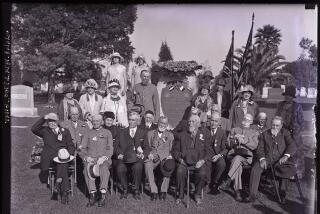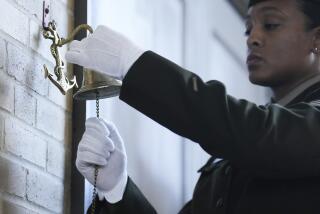Keeping the Buffalo Soldiers on memory’s front lines
- Share via
They participated in cross-country cattle drives, escorted wagon trains and stagecoaches through often volatile territories of the Wild West and fought in the Spanish-American War and both world wars.
The first African American regiments of the U.S. Army were commonly known as Buffalo Soldiers.
Today, they are among a rapidly shrinking group of veterans who with each passing year renew their commitment to ensuring that their contribution to American military history is recognized — and never forgotten.
“Our aim is to perpetuate the memory of the Buffalo Soldiers and tell the true story of what happened,” said Bruce E. Dennis, 86, vice president of the Inglewood-based Greater Los Angeles-area chapter of the 9th and 10th (Horse) Cavalry Assn.
Authorized by an act of Congress in 1866, the 9th and 10th Cavalry, and later the 24th and 25th Infantry, formed the first African American regiments of the U.S. Army. They were initially led by white officers and constituted about 10% of troops who guarded the western frontier for more than two decades, according to the Buffalo Soldiers National Museum in Houston.
The total number of original Buffalo Soldiers still living nationwide is unclear, but there are more than two dozen chapters of 9th and 10th Cavalry associations across the country. They include branches in San Diego and the Inland Empire, where the local Buffalo Soldiers Heritage Assn. is raising funds for a memorial at Riverside National Cemetery.
In recent years, participation in the monthly meetings of the Inglewood group has waned, but the mission of the handful of original surviving members remains the same: to educate the public about their historic significance.
“We are trying to keep the legacy alive,” said Andrew Q. Isaacs, 87, who was an active member of the Inglewood group until he recently relocated to Sacramento. “We want people to remember us.”
Dennis said the men are often invited to speak at schools and to participate in holiday parades and other events.
The ex-soldiers delight in telling how the nickname Buffalo Soldiers came about. Some say it was bestowed on African American soldiers by Native American warriors, who respected their fierce fighting ability, Isaacs said. Others believe that Native Americans likened the short curly hair of black troops to that of the buffalo, or were referring to the heavy buffalo coats worn by the soldiers in winter.
“Many of the soldiers they show in the movies, when the cavalry comes riding to the rescue, they would have been black,” said Waldo E. Henderson, 86, another surviving L.A.-area Buffalo Soldier, noting that such details are often ignored.
Every year, Buffalo Soldier chapters from the around the country convene at a national convention to socialize, celebrate the association’s founding and honor veterans of past service.
The horse cavalry regiments were deactivated during World War II, and its soldiers were deployed to various service units, according to historical records. But they remained Buffalo Soldiers.
Dennis, Henderson and Isaacs acknowledged that they were little acquainted with the history of the 9th and 10th Cavalry when they enlisted — or were drafted — into the Army. The role of Buffalo Soldiers in U.S. military history was rarely acknowledged, they said.
Isaacs, who enlisted in the 10th Cavalry in 1940, received his basic training at Ft. Leavenworth, Kan., where he learned how to ride and take care of horses. He loved the Army. It fostered discipline and camaraderie. He later worked for a colonel—keeping the officer’s boots and equipment polished and his horse groomed for extra pay.
“It was better than doing regular, routine chores,” he said. “The colonel I worked for was a good man.”
Isaacs eventually spent time in Arizona, Louisiana, California and the Solomon Islands. He was discharged in 1945 with the rank of technical sergeant.
Henderson, 86, resented being drafted into the Army. He was studying English at Langston University, Oklahoma’s sole black college, and had planned to become a schoolteacher. He didn’t want to interrupt his education “to go fight somebody,” especially not in a segregated Army, he said.
Henderson still bristles when he recalls the humiliating treatment black soldiers received.
Traveling through Southern states such as Texas, Alabama, Georgia and Virginia, African American soldiers were ordered to lower the blinds on the train “because whites didn’t want to see black soldiers in uniform,” Henderson said.
“And the horses were allowed to get off the train to exercise, but the cavalrymen were not,” he added.
For Dennis, a former master sergeant who served in the same 10th Cavalry platoon as Henderson, his most memorable assignment was the two years he spent in the small Italian town of Santa Maria. His duties included checking the food and ammunition boxes and loading them onto trains bound for the front. At least 60 Italians were assigned to work for him, recalled Dennis, who even had a housekeeper, a cook and laundry service.
“It made us feel much more important,” he said. “These Italians had never seen black soldiers before. The white soldiers had told them that we had tails.”
To add insult to injury, Dennis helped build prisoner-of-war camps near the Italian town of Pisa for more than 2,000 captured German troops, who he said were treated better than the black cavalrymen.
“It was horrible,” he said. “They issued all the German POWs with brand-new fatigues. My unit got patched, used fatigues.”
In 1948, President Truman signed an executive order calling for “equality of treatment for all persons in the armed services,” regardless of race, religion or national origin.
“Truman did a very profound thing for black soldiers. We started to get the same respect,” said Henderson, who was discharged with the rank of technical engineer.
In 1992, retired Gen. Colin Powell, then chairman of the Joint Chiefs of Staff, dedicated a monument to the Buffalo Soldiers at Ft. Leavenworth, where the 10th Cavalry was born.
Isaacs, Dennis and Henderson attended the celebration.
Henderson said the dedication changed his feelings about the Army.
“We had no recognition before,” he said. “It changed the whole view of black soldiers. I can proudly say now that I was a Buffalo Soldier.”
More to Read
Sign up for The Wild
We’ll help you find the best places to hike, bike and run, as well as the perfect silent spots for meditation and yoga.
You may occasionally receive promotional content from the Los Angeles Times.







